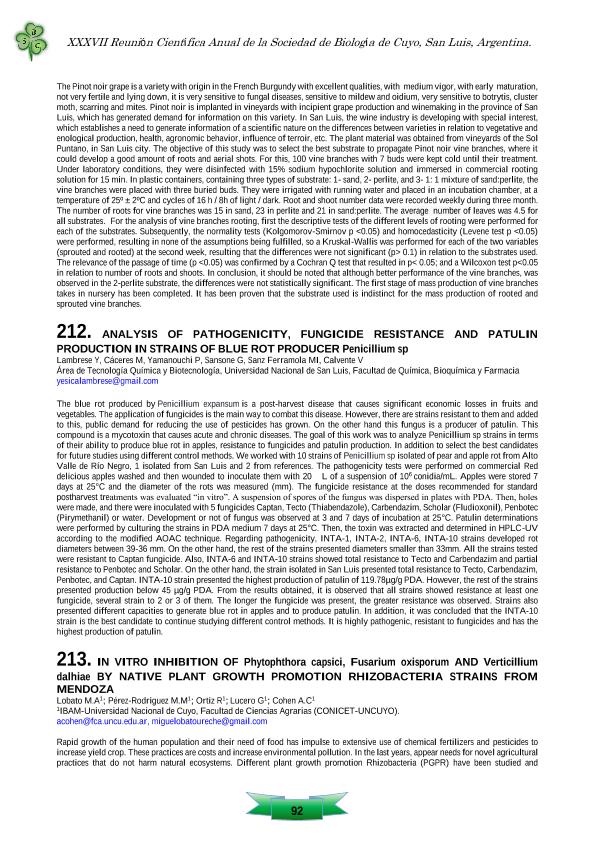Mostrar el registro sencillo del ítem
dc.contributor.author
Lobato Ureche, Miguel Andres

dc.contributor.author
Pérez Rodriguez, María Micaela

dc.contributor.author
Ortiz, R.
dc.contributor.author
Lucero, Gabriela Susana

dc.contributor.author
Cohen, Ana Carmen

dc.date.available
2022-03-31T11:09:52Z
dc.date.issued
2019
dc.identifier.citation
In vitro inhibition of Phytophthora capsici, Fusarium oxisporum and Verticillium dalhiae by native plant growth promotion rhizobacteria strains from Mendoza; XXXVII Reunión Científica Anual de la Sociedad de Biología de Cuyo; San Luis; Argentina; 2019; 92-93
dc.identifier.uri
http://hdl.handle.net/11336/154101
dc.description.abstract
The rapid growth of the human population and their need of food has impulse to extensive use of chemical fertilizers and pesticides to increase yield crop. These practices are costs and increase environmental pollution. In the last years, appear needs for novel agricultural practices that do not harm natural ecosystems. Different plant growth promotion Rhizobacteria (PGPR) have been studied and incorporated into agricultural practices and biocontrol has emerged in recent years as an alternative to pesticides. PGPR antagonize orprevent the effects of phytopathogens or deleterious microorganisms. PGPR produce substances that protect them against variousdiseases. Metabolites include hydrogen cyanide and antibiotics. Some strain PGPRs produce lytic enzymes as β-1,3-glucanase,chitinase, protease and cellulase that degrade the cell wall of fungi and produce a direct inhibitory effect on the growth of hyphae.Another important mechanism of biocontrol of PGPRs is related to the production of siderophores that chelate iron, making itunavailable to pathogens. In this study four native PGPR strains of Mendoza against pathogenic fungi of pepper crops were evaluated.The test was carried out by fourfold and repeated two times using independent Petri dishes for the growth of each bacterial strain andeach pathogens. On Luria Broth (LB) and potato dextrose agar (PDA) plates, one disc of a 5 mm plug carrying mycelia fungi (P.capsici, F. oxisporum or V. dalhiae) previously grown for 3 days in PDA was placed and each individual bacterium (60I1, 53F, 64S1,42P4) was plated as line. Bacterial strains were cultivated in LB medium for 24 h at 30 °C with orbital shaking (120 rpm). The bacterialcultures were adjusted to a final concentration of 108cells mL−1. The assay was performed incubated at 30 °C for 7 days. The myceliumgrowth was digitally determined every day. A control plate was included growing with the fungi. The percentage of inhibition was calculated comparing to the control. The strains 53F, 64S1 y 42P4 inhibited F. oxisporum and V. dalhiae in vitro mycelium growth.The 42P4 strain inhibited the P. capsici growth in APG plates. Also, we observed the production pyoverdine by 42P4 strain under UV in APG medium.
dc.format
application/pdf
dc.language.iso
eng
dc.publisher
Universidad Nacional de San Luis
dc.rights
info:eu-repo/semantics/openAccess
dc.rights.uri
https://creativecommons.org/licenses/by-nc-sa/2.5/ar/
dc.subject
BIOCONTROL
dc.subject
IN VITRO
dc.subject
PGPR
dc.subject.classification
Horticultura, Viticultura

dc.subject.classification
Agricultura, Silvicultura y Pesca

dc.subject.classification
CIENCIAS AGRÍCOLAS

dc.title
In vitro inhibition of Phytophthora capsici, Fusarium oxisporum and Verticillium dalhiae by native plant growth promotion rhizobacteria strains from Mendoza
dc.type
info:eu-repo/semantics/publishedVersion
dc.type
info:eu-repo/semantics/conferenceObject
dc.type
info:ar-repo/semantics/documento de conferencia
dc.date.updated
2022-03-16T19:16:14Z
dc.journal.pagination
92-93
dc.journal.pais
Argentina

dc.journal.ciudad
San Luis
dc.description.fil
Fil: Lobato Ureche, Miguel Andres. Consejo Nacional de Investigaciones Científicas y Técnicas. Centro Científico Tecnológico Conicet - Mendoza. Instituto de Biología Agrícola de Mendoza. Universidad Nacional de Cuyo. Facultad de Ciencias Agrarias. Instituto de Biología Agrícola de Mendoza; Argentina
dc.description.fil
Fil: Pérez Rodriguez, María Micaela. Consejo Nacional de Investigaciones Científicas y Técnicas. Centro Científico Tecnológico Conicet - Mendoza. Instituto de Biología Agrícola de Mendoza. Universidad Nacional de Cuyo. Facultad de Ciencias Agrarias. Instituto de Biología Agrícola de Mendoza; Argentina
dc.description.fil
Fil: Ortiz, R.. Universidad Nacional de Cuyo. Facultad de Ciencias Agrarias; Argentina
dc.description.fil
Fil: Lucero, Gabriela Susana. Consejo Nacional de Investigaciones Científicas y Técnicas. Centro Científico Tecnológico Conicet - Mendoza. Instituto de Biología Agrícola de Mendoza. Universidad Nacional de Cuyo. Facultad de Ciencias Agrarias. Instituto de Biología Agrícola de Mendoza; Argentina
dc.description.fil
Fil: Cohen, Ana Carmen. Consejo Nacional de Investigaciones Científicas y Técnicas. Centro Científico Tecnológico Conicet - Mendoza. Instituto de Biología Agrícola de Mendoza. Universidad Nacional de Cuyo. Facultad de Ciencias Agrarias. Instituto de Biología Agrícola de Mendoza; Argentina
dc.relation.alternativeid
info:eu-repo/semantics/altIdentifier/url/https://sbcuyo.org.ar/wp-content/uploads/2019/12/Libro-BIOCELL-2019.pdf
dc.conicet.rol
Autor

dc.conicet.rol
Autor

dc.conicet.rol
Autor

dc.conicet.rol
Autor

dc.conicet.rol
Autor

dc.coverage
Nacional
dc.type.subtype
Reunión
dc.description.nombreEvento
XXXVII Reunión Científica Anual de la Sociedad de Biología de Cuyo
dc.date.evento
2019-12-05
dc.description.ciudadEvento
San Luis
dc.description.paisEvento
Argentina

dc.type.publicacion
Book
dc.description.institucionOrganizadora
Sociedad de Biología de Cuyo
dc.source.libro
Libro de Resúmenes: XXXVII Reunión Científica Anual Sociedad de Biología de Cuyo
dc.date.eventoHasta
2019-12-06
dc.type
Reunión
Archivos asociados
